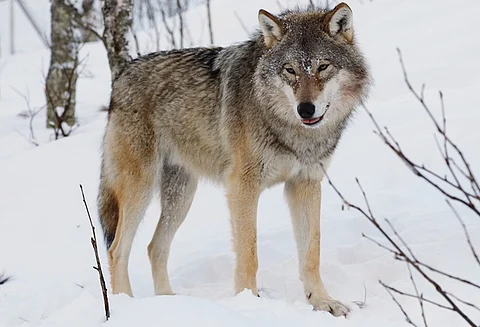

Europe is home to over 20,000 wolves (Canis lupus) and the species is continuing to make a remarkable comeback across the continent, a study published by a team of researchers on February 25, 2025, has found.
But as wolf numbers in Europe increase, their coexistence with human activities, notably farming and hunting, remains a challenge and requires navigating complex social, economic, and political contexts the study adds.
The team of researchers based their estimate on monitoring reports and expert assessments in 34 countries.
They found that by 2022 at least 21,500 wolves inhabited Europe, 19,000 of which were found in the European Union (EU). This, according to the researchers, is an increase of 58 per cent from the 12,000 estimated 10 years ago.
“In most countries, wolf populations have continued to increase and are now found in all but the smallest countries of mainland Europe. Several countries — Bulgaria, Greece, Germany, Italy, Poland, Spain, and Romania — now have more than 1,000 individuals each. For a variety of reasons including management goals (i.e., population caps) or the relatively recent recolonization of the species after a long absence, some countries have fewer than 100 individuals (Austria, Belgium, Denmark, Hungary, Luxembourg, Norway, and the Netherlands). The three microstates of Monaco, San Marino and The Vatican remain the only countries in mainland Europe not having experienced wolf recolonization,” the paper noted.
In some countries, the species is growing at an incredible pace. In Germany for instance, wolves increased from 1 pack in 2000 to 184 packs and 47 pairs in 2022.
“Assessing wolf population dynamics in their respective countries, authors of the current paper reported that, during the last decade, wolf numbers increased in 19 countries (Austria, Belgium, Bulgaria, Czech Republic, Denmark, Finland, France, Germany, Greece, Hungary, Italy, Lithuania, The Netherlands, Poland, Slovak Republic, Slovenia, Sweden, Switzerland and the European part of Türkiye), remained broadly stable in 8 countries (Albania, Croatia, Luxembourg, Norway, Portugal, Romania, Spain, Ukraine), fluctuated in three countries (Estonia, Latvia, Serbia) and decreased in three countries (Bosnia & Herzegovina, Montenegro, North Macedonia) while the situation in Kosovo is unknown,” the team observed.
The largest wolf populations (Dinaric Balkan, Carpathian) are increasing, with smaller populations (Central European, Western Central Alps) displaying even larger growth rates.
Some populations (Scandinavian and Karelian) have experienced slower growth, and even stagnation, because of intensive management actions (lethal control and hunter harvest). Only the Nordic countries (Finland, Norway, and Sweden) and Austria appear to have limited their recovering wolf populations.
A small, isolated population in southern Spain is the only European wolf population to become extinct in recent years, noted the paper.
The researchers added that “overall, wolves have shown an ability to recover in highly-altered, multi-use landscapes on a continental scale when they are permitted to do so, confirming the extraordinary adaptability of this species”.
They added that wolf recovery in the continent showed a large predatory species can successfully share landscapes with high densities of humans. They compared this to leopards (Panthera pardus) occurring and breeding at the edges of large urban and in densely populated agricultural areas in India.
So, what are the reasons for this conservation triumph? Wolves are, of course, highly adaptable. “Their recovery has certainly benefited from their opportunistic ecology (in contrast, the Eurasian lynx (Lynx lynx) and brown bear (Ursus arctos) have not experienced the same extent of recovery). Favorable social, legal and institutional contexts have also contributed to this recovery. Among the predators listed in the EU Habitats Directive, the wolf has possibly experienced the strongest population growth. This shows that, with appropriate policy instruments, land-sharing models can work, even for apex predators, on continental scales.”
But the team warned that the challenge now will be to adapt conservation policies as they transition from saving endangered populations to sustaining success.
In the EU, wolves share the landscape with millions of wild ungulates, 279 million head of livestock and 449 million people.
Wolves annually kill approximately 56,000 domestic animals in the EU, a risk unevenly distributed and differently handled across regions. Damage compensation costs 17 million EUR every year to European countries.
The authors added that positive economic impacts from wolf presence, such as those related to reducing traffic accidents with wild ungulates or supporting wildlife tourism, remain under studied.
“Coexisting with newly established wolf populations in Europe entails managing impacts on human activities, including livestock depredation, competition for game, and fear of attacks on humans, amidst varying social and political views on wolf recovery. Sustainable coexistence continues to operate in evolving and complex social, economic, and political landscapes, often characterized by intense debates regarding wolf policies,” they wrote.
They noted that an emerging but no less critical aspect will be to avoid wolf, and nature conservation at large, becoming embroiled in “culture wars” and being perceived as wedge issues that sharpen the divide between progressive versus conservative ideologies.
Continuing recovery of wolves in Europe has been published in PLOS Sustainability and Transformation.
The authors are Cecilia Di Bernardi, Guillaume Chapron, Petra Kaczensky, Francisco Álvares, Henrik Andrén, Vaidas Balys, Juan Carlos Blanco, Silviu Chiriac, Duško Ćirović, Nolwenn Drouet-Hoguet, Djuro Huber, Yorgos Iliopoulos, Ilpo Kojola, Miha Krofel, Miroslav Kutal, John D. C. Linnell, Aleksandra Majić Skrbinšek, Peep Männil, Francesca Marucco, Dime Melovski, Deniz Mengüllüoğlu, Joachim Mergeay, Robert W. Mysłajek, Sabina Nowak, Jānis Ozoliņš, Nathan Ranc, Ilka Reinhardt, Robin Rigg, Valeria Salvatori, Laurent Schley, Peter Sunde, Aleksandër Trajçe, Igor Trbojević, Arie Trouwborst, Manuela von Arx, Diana Zlatanova and Luigi Boitani.